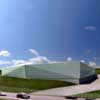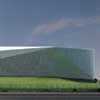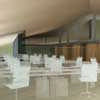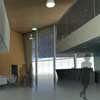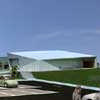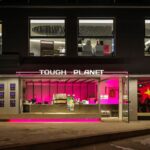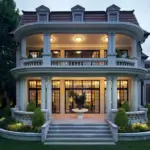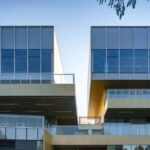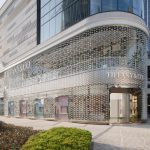John Deere Madrid Showroom, Spanish Retail Architecture Images, Architect, Design
John Deere Madrid Showroom
Parla Building: Showroom in Spain design by Estudio Lamela Architects
14 Nov 2008
John Deere Showroom Madrid
Situated on the plot PAU 5, Parla, Madrid
Design: Estudio Lamela, Architects
John Deere Madrid Building
Arquitectura España
Estudio Lamela Architects designs a new show-room, built-in training and marketing centre for John Deere in Spain.
Building surface of 5.500 square meters, on the plot of a gross area of 60.000 m for accommodating the companies tractors and machinery exhibition zone and being used as training and marketing centre for all Spanish dealers.
The objective of the construction is to convert the building into a small ¨architectural highlight¨ for Parla. The inauguration will take place at the beginning of 2009. Total investment planned is 12 million euros.
The building is expected to host a 1.000-meters exhibition centre with seating capacity for 180 people, a training centre with workshop and classrooms, John Deere Credit offices, the company financial branch, and services zones, court yard and car park.
Madrid, October 2008. Last September took place ¨la puesta de bandera¨ which is the finalization of the main structure for the new show-room, built-in training and marketing center for JOHN DEERE in Spain, designed by ESTUDIO LAMELA and constructed by Acciona, situated at PAU 5 in Parla, Madrid. The building will have three basic functions: products exhibition, training centre and head offices for the multifunctional American company dedicated to sales of tractors and agricultural machinery.
The show-room is located at Parla Development Sector 5 and has a gross area of 60.000 square meters, of which more than 40.000 sq meters will be destined to carry out new technologies application tests, as the practical part of education programs, 5.500 sq meters will correspond to constructed area. The building will provide a 1.000 sq meters exhibition centre with 180 people seating capacity, training centre with classrooms and workshop, John Deere Credit offices, the company financial branch, and services zones, court yard and parking lot.
For Carlos Lamela ¨the design has represented a great challenges for the team due to the diversity of components of the brief and the peculiarity of the product and moreover the challenge of working for JOHN DEERE, a brand of highest international standards. From the beginning we have known that we would like to give the design similarities with the American 50’s agricultural industrial esthetics, the product to be exposed showed us clearly the relation between them¨ declared Carlos Lamela.
The building has been conceived taking into account the plot peculiarity, its inclined topography and its location in the dry and hostile zone in the south of Madrid, characterized by special climatic conditions. The organization of the surroundings have been conceived to provide maximum protecting from the sun. For the same reason, the car park has been located at a certain distance from the building and has been provided with vegetation so that the temperatures at floor level are not being transmitted to the building.
Design and roof characteristics
The U-shaped building evokes the “cortijos”, country side sheds disposed as ¨patio buildings¨ of Spanish tradition, where everything revolves around a function, in this case the products sold by John Deere. It is closed to the exterior, to the city and the road while showing its most public façade, suggesting movements with its non-orthogonal roof and façade.
The building has a volume which is primarily disposed horizontally and the roof is a very important element in the conception of the project. With its geometry it pretends to give an idea of the irregular ground. It is a continuous element which disposes of different angles of inclination which do not only suggests a sensation of movement but also is consistent with building’s functions located below and allows to take advantage of the different orientations. Likewise, it has been designed so that tractors and other type of machinery can access the building in order to be exhibited.
The exterior skin complies with a double function: Homogenize the image of the building and give permanent solar shelter in all orientations and at all times throughout the year. The building therefore is conceived as a continuous skin of corrugated metal deck, only interrupted to introduce the gallery which surrounds the court yard at ground level where the skin opens up making permeable the relation between the interior and exterior of the building.
With regard to the U-shape, exterior-interior, there are three levels of approach: one from a distance, corresponding to the city, an intermediate at urban level, where the vehicles´ circulation is already slower, the building is raised but the activity taking place in the plot can still not be observed. The main entrance to the building and the tractor exhibition space next to it become protagonists as a continuous reference from street level of the exterior access road. The third level of approach, the closest to the building, is framed by both the paving´s geometry from the access to the plot and by the emerging volume of the building up to the entrance vestibule.
In the interior the shape also favors the coexistence of different uses, distributed according to a linear scheme of circulation, within a brief that does not require a visual connection between spaces but where everyone can share the John Deere experience around the inner court yard.
John Deere Madrid images / information from Estudio Lamela Architects
Location: Madrid, Spain
Madrid Architecture
Contemporary Madrid Architecture
Madrid Architecture Walking Tours by e-architect
Estudio Lamela
Estudio Lamela Architects
Estudio Lamela is one of the largest Spanish architectural firms, having an impressive past of over half a century of professional activity encompassing more than 1600 projects. Carlos Lamela has been managing the company since 1987, as the successor of Antonio Lamela who established the company in the 50’s. Currently his company is staffed by more than 100 professionals working from offices in Poland, Dubai and Mexico. Estudio Lamela has developed such a important projects as Expo 2008 in Zaragoza, the new Real Madrid Sports City, the Santiago Bernabeu Stadium, the New Terminal 4 at Madrid- Barajas Airport and the extension of Warsaw- Okecie Airport.
Buildings in the Spanish Capital
Bernabeu Stadium – Real Madrid football club
Architects: Estudio Lamela
Bernabeu Stadium
Blue Building, Alcobendas, north of Spanish capital
Design: Rafael de La-Hoz Arquitectos
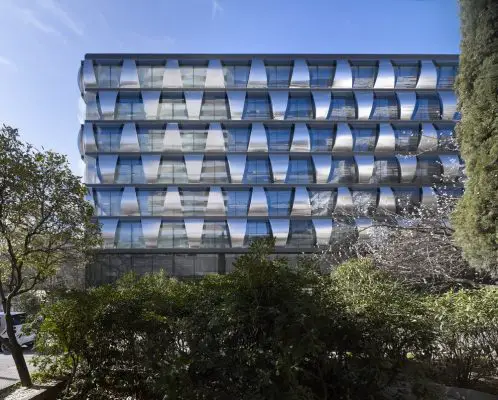
photographer : Alfonso Quiroga
Blue Building in Madrid
Buildings / photos for the John Deere Spain Madrid Showroom page welcome
Website: www.deere.com

